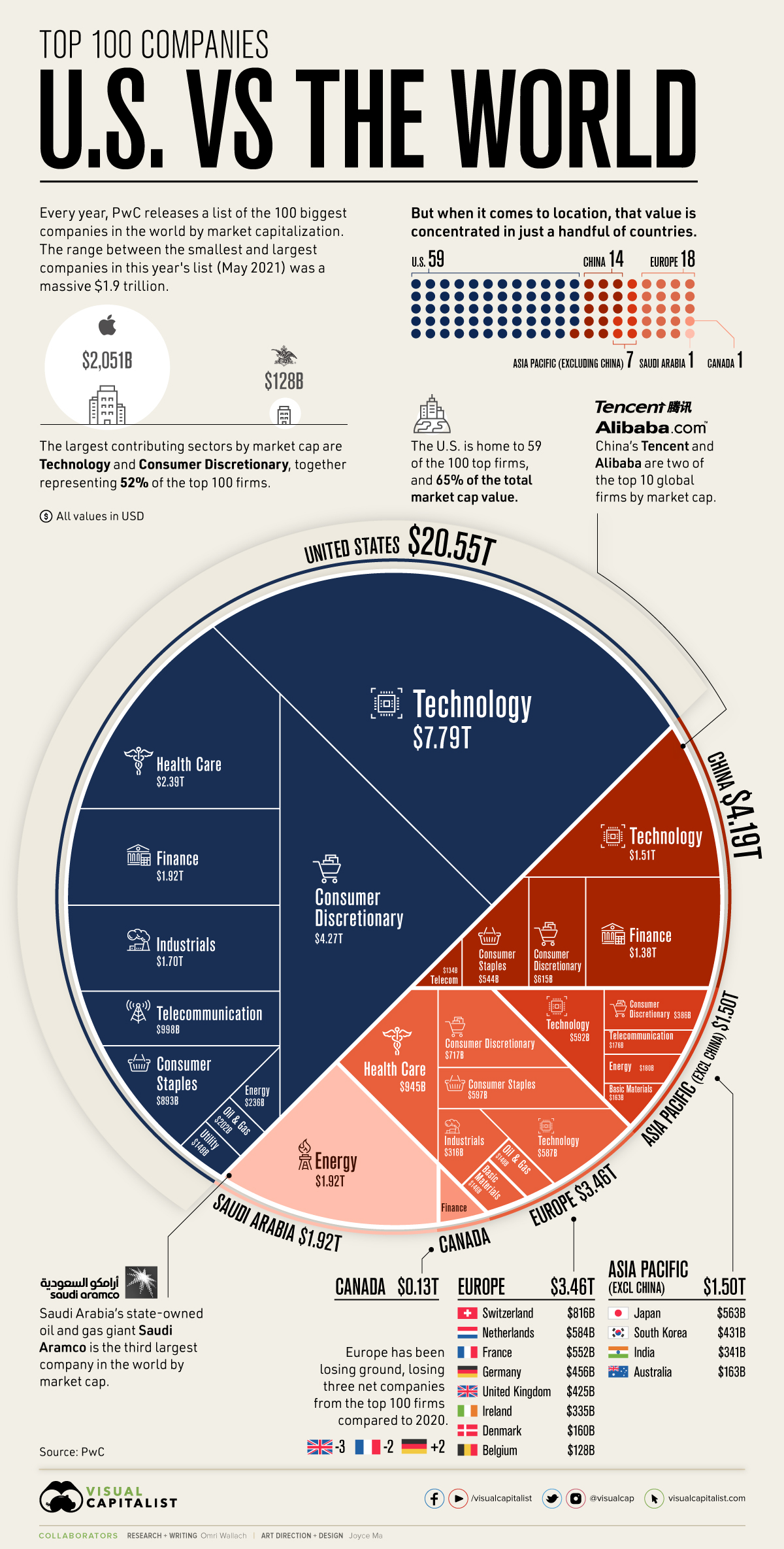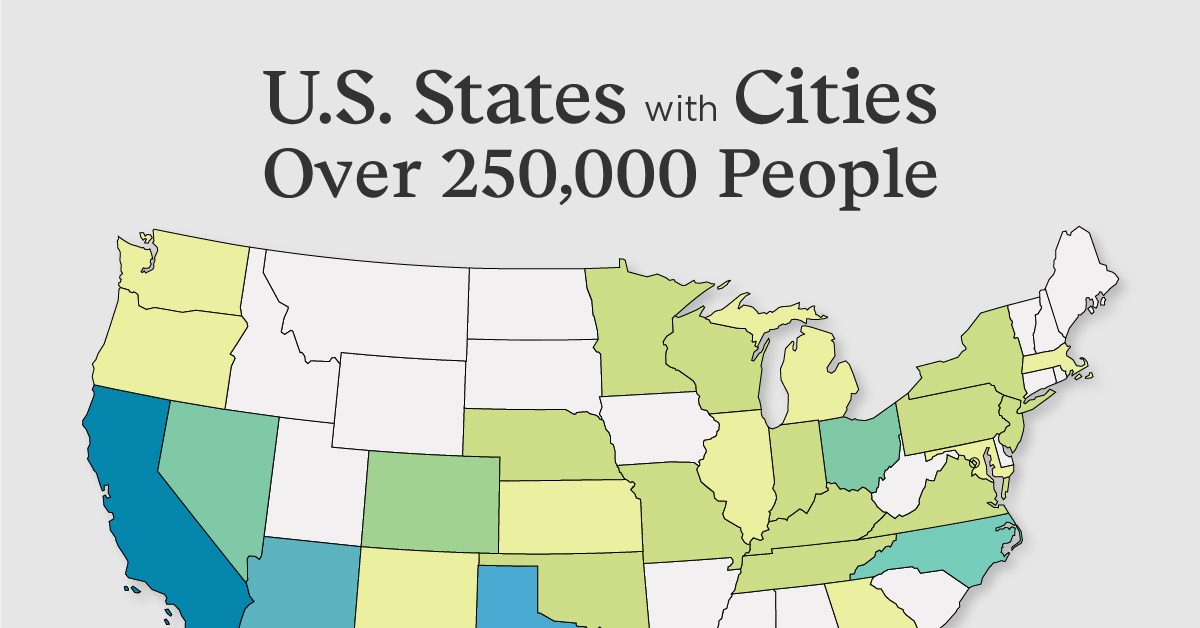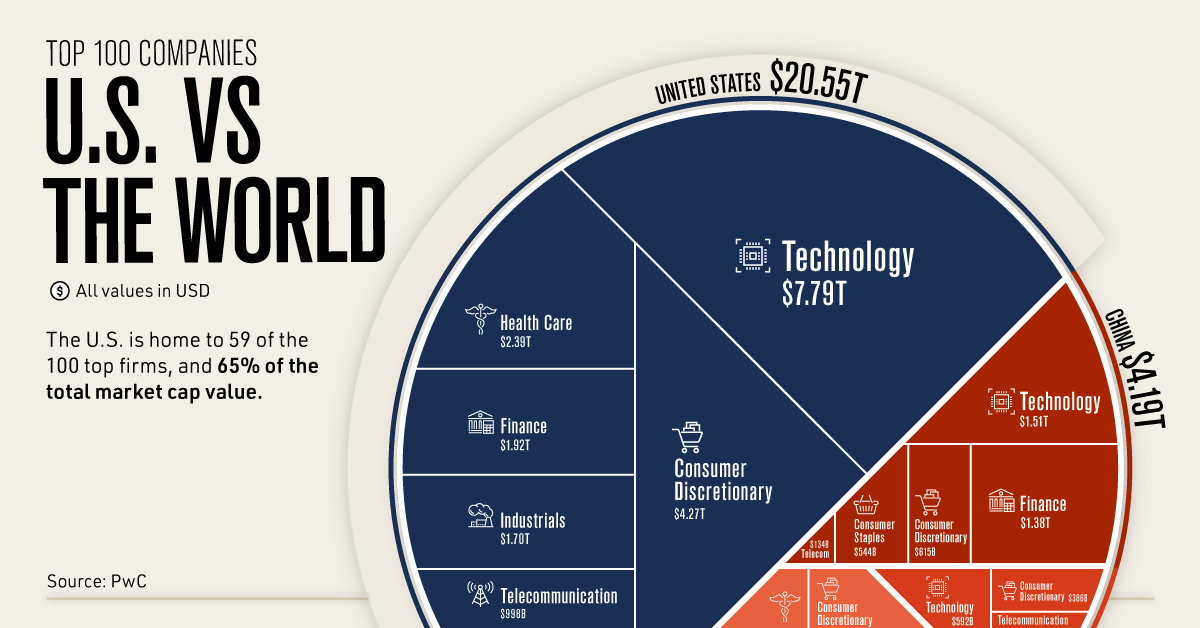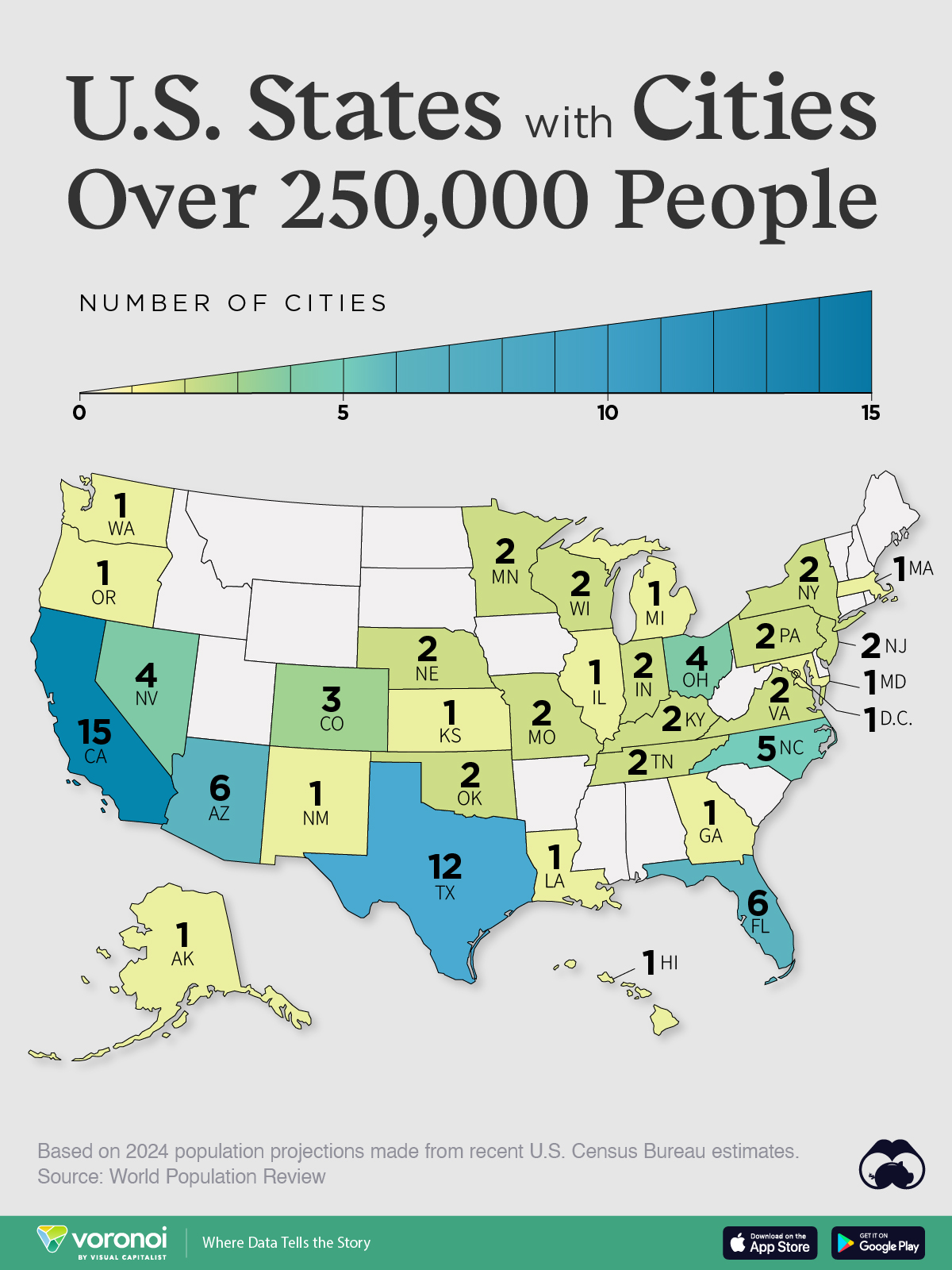United States
The Top 100 Companies of the World: The U.S. vs Everyone Else

The Top 100 Companies of the World: U.S. vs Everyone
When it comes to breaking down the top 100 companies of the world, the United States still commands the largest slice of the pie.
Throughout the 20th century and before globalization reached its current peaks, American companies made the country an economic powerhouse and the source of a majority of global market value.
But even as countries like China have made headway with multi-billion dollar companies of their own, and the market’s most important sectors have shifted, the U.S. has managed to stay on top.
How do the top 100 companies of the world stack up? This visualization pulls from PwC’s annual ranking of the world’s largest companies, using market capitalization data from May 2021.
Where are the World’s Largest Companies Located?
The world’s top 100 companies account for a massive $31.7 trillion in market cap, but that wealth is not distributed evenly.
Between companies, there’s a wide range of market caps. For example, the difference between the world’s largest company (Apple) and the 100th largest (Anheuser-Busch) is $1.9 trillion.
And between countries, that divide becomes even more stark. Of the 16 countries with companies making the top 100 ranking, the U.S. accounts for 65% of the total market cap value.
| Location | # of Companies | Market Capitalization (May 2021) |
|---|---|---|
| 🇺🇸 United States | 59 | $20.55T |
| 🇨🇳 China | 14 | $4.19T |
| 🇸🇦 Saudi Arabia | 1 | $1.92T |
| 🇨🇭 Switzerland | 3 | $0.82T |
| 🇳🇱 Netherlands | 3 | $0.58T |
| 🇯🇵 Japan | 3 | $0.56T |
| 🇫🇷 France | 2 | $0.55T |
| 🇩🇪 Germany | 3 | $0.46T |
| 🇰🇷 South Korea | 1 | $0.43T |
| 🇬🇧 United Kingdom | 3 | $0.43T |
| 🇮🇳 India | 2 | $0.34T |
| 🇮🇪 Ireland | 2 | $0.34T |
| 🇦🇺 Australia | 1 | $0.16T |
| 🇩🇰 Denmark | 1 | $0.16T |
| 🇨🇦 Canada | 1 | $0.13T |
| 🇧🇪 Belgium | 1 | $0.13T |
Compared to the U.S., other once-prominent markets like Japan, France, and the UK have seen their share of the world’s top 100 companies falter over the years. In fact, all of Europe accounts for just $3.46 trillion or 11% of the total market cap value of the list.
A major reason for the U.S. dominance in market values is a shift in important industries and contributors. Of the world’s top 100 companies, 52% were based in either technology or consumer discretionary, and the current largest players like Apple, Alphabet, Tesla, and Walmart are all American-based.
The Top 100 Companies of the World: Competition From China
The biggest and most impressive competitor to the U.S. is China.
With 14 companies of its own in the world’s top 100, China accounted for $4.19 trillion or 13% of the top 100’s total market cap value. That includes two of the top 10 firms by market cap, Tencent and Alibaba.
| Company | Country | Sector | Market Cap (May 2021) | |
|---|---|---|---|---|
| #1 | Apple | United States | Technology | $2,051B |
| #2 | Saudi Aramco | Saudi Arabia | Energy | $1,920B |
| #3 | Microsoft | United States | Technology | $1,778B |
| #4 | Amazon | United States | Consumer Discretionary | $1,558B |
| #5 | Alphabet | United States | Technology | $1,393B |
| #6 | United States | Technology | $839B | |
| #7 | Tencent | China | Technology | $753B |
| #8 | Tesla | United States | Consumer Discretionary | $641B |
| #9 | Alibaba | China | Consumer Discretionary | $615B |
| #10 | Berkshire Hathway | United States | Financials | $588B |
| #11 | TSMC | China | Technology | $534B |
| #12 | Visa | United States | Industrials | $468B |
| #13 | JPMorgan Chase | United States | Financials | $465B |
| #14 | Johnson & Johnson | United States | Health Care | $433B |
| #15 | Samsung Electronics | South Korea | Technology | $431B |
| #16 | Kweichow Moutai | China | Consumer Staples | $385B |
| #17 | Walmart | United States | Consumer Discretionary | $383B |
| #18 | Mastercard | United States | Industrials | $354B |
| #19 | UnitedHealth Group | United States | Health Care | $352B |
| #20 | LVMH Moët Hennessy | France | Consumer Discretionary | $337B |
| #21 | Walt Disney Co | United States | Consumer Discretionary | $335B |
| #22 | Bank of America | United States | Financials | $334B |
| #23 | Procter & Gamble | United States | Consumer Staples | $333B |
| #24 | Nvidia | United States | Technology | $331B |
| #25 | Home Depot | United States | Consumer Discretionary | $329B |
| #26 | Nestle SA | Switzerland | Consumer Staples | $322B |
| #27 | ICBC | China | Financials | $290B |
| #28 | Paypal Holdings | United States | Industrials | $284B |
| #29 | Roche Holdings | Switzerland | Health Care | $283B |
| #30 | Intel | United States | Technology | $261B |
| #31 | ASML Holding NV | Netherlands | Technology | $255B |
| #32 | Toyota Motor | Japan | Consumer Discretionary | $254B |
| #33 | Comcast | United States | Telecommunication | $248B |
| #34 | Verizon Communications | United States | Telecommunication | $241B |
| #35 | Exxon Mobil | United States | Energy | $236B |
| #36 | Netflix | United States | Consumer Discretionary | $231B |
| #37 | Adobe | United States | Technology | $228B |
| #38 | Coca-Cola Co | United States | Consumer Staples | $227B |
| #39 | Meituan | China | Technology | $226B |
| #40 | Ping An | China | Financials | $219B |
| #41 | Cisco Systems | United States | Telecommunication | $218B |
| #42 | AT&T | United States | Financials | $216B |
| #43 | L'Oréal | France | Consumer Discretionary | $215B |
| #44 | China Construction Bank | China | Financials | $213B |
| #45 | Abbott Labs | United States | Health Care | $212B |
| #46 | Novartis AG | Switzerland | Health Care | $212B |
| #47 | Nike | United States | Consumer Discretionary | $209B |
| #48 | Oracle | United States | Technology | $202B |
| #49 | Pfizer | United States | Health Care | $202B |
| #50 | Chevron | United States | Oil & Gas | $202B |
| #51 | China Merchants Bank | China | Financials | $196B |
| #52 | PepsiCo | United States | Consumer Staples | $195B |
| #53 | Salesforce.com | United States | Technology | $195B |
| #54 | Merck & Co | United States | Health Care | $195B |
| #55 | AbbVie | United States | Health Care | $191B |
| #56 | Broadcom | United States | Technology | $189B |
| #57 | Prosus NV | Netherlands | Technology | $181B |
| #58 | Reliance Industries | India | Energy | $180B |
| #59 | Thermo Fisher Scientific | United States | Health Care | $180B |
| #60 | Eli Lilly & Co | United States | Health Care | $179B |
| #61 | Agricultural Bank of China | China | Financials | $178B |
| #62 | Softbank Group | Japan | Telecommunication | $176B |
| #63 | Accenture | Ireland | Industrials | $176B |
| #64 | Texas Instruments | United States | Technology | $174B |
| #65 | McDonalds | United States | Consumer Discretionary | $167B |
| #66 | Volkswagen AG | Germany | Consumer Discretionary | $165B |
| #67 | BHP Group | Australia | Basic Materials | $163B |
| #68 | Wells Fargo & Co | United States | Financials | $162B |
| #69 | Tata Consultancy Services | India | Technology | $161B |
| #70 | Danaher | United States | Health Care | $160B |
| #71 | Novo Nordisk | Denmark | Health Care | $160B |
| #72 | Medtronic | Ireland | Health Care | $159B |
| #73 | Wuliangye Yibin | China | Consumer Staples | $159B |
| #74 | Costco Wholesale | United States | Consumer Discretionary | $156B |
| #75 | T-Mobile US | United States | Telecommunication | $156B |
| #76 | Citigroup | United States | Financials | $152B |
| #77 | Honeywell | United States | Industrials | $151B |
| #78 | Qualcomm | United States | Technology | $151B |
| #79 | SAP SE | Germany | Technology | $151B |
| #80 | Boeing | United States | Industrials | $149B |
| #81 | Royal Dutch Shell | Netherlands | Oil & Gas | $148B |
| #82 | NextEra Energy | United States | Utilities | $148B |
| #83 | United Parcel Service | United States | Industrials | $148B |
| #84 | Union PAC | United States | Industrials | $148B |
| #85 | Unilever | United Kingdom | Consumer Staples | $147B |
| #86 | AIA | China | Financials | $147B |
| #87 | Linde | United Kingdom | Basic Materials | $146B |
| #88 | Amgen | United States | Health Care | $144B |
| #89 | Bristol Myers Squibb | United States | Health Care | $141B |
| #90 | Siemens AG | Germany | Industrials | $140B |
| #91 | Bank of China | China | Financials | $139B |
| #92 | Philip Morris | United States | Consumer Staples | $138B |
| #93 | Lowe's Companies | United States | Consumer Discretionary | $136B |
| #94 | Charter Communications | United States | Telecommunication | $135B |
| #95 | China Mobile | China | Telecommunication | $134B |
| #96 | Sony Group | Japan | Consumer Discretionary | $132B |
| #97 | Astrazeneca | United Kingdom | Health Care | $131B |
| #98 | Royal Bank of Canada | Canada | Financials | $131B |
| #99 | Starbucks | United States | Consumer Discretionary | $129B |
| #100 | Anheuser-Busch | Belgium | Consumer Staples | $128B |
Impressively, China’s rise in market value isn’t limited to well-known tech and consumer companies. The country’s second biggest contributing industry to the top 100 firms was finance, once also the most valuable sector in the U.S. (currently 4th behind tech, consumer discretionary, and health care).
Other notable countries on the list include Saudi Arabia and its state-owned oil and gas giant Saudi Aramco, which is the third largest company in the world. Despite only having one company in the top 100, Saudi Arabia had the third-largest share of the top 100’s total market cap value.
As Europe continues to lose ground year-over-year and the rest of Asia struggles to keep up, the top 100 companies might become increasingly concentrated in just the U.S. and China. The question is, will the imbalance of global market value start to even out, or become even bigger?
United States
Mapped: U.S. States By Number of Cities Over 250,000 Residents
Eighteen U.S. States don’t have a single incorporated area with more than 250,000 people.

Mapped: U.S. States By Number of Cities Over 250K Residents
This was originally posted on our Voronoi app. Download the app for free on iOS or Android and discover incredible data-driven charts from a variety of trusted sources.
Over 80% of the American population lives in an “urban area” according to the U.S. Census Bureau. But where are all of the country’s largest cities, and what patterns can we see from their state locations?
This map shows U.S. states by their number of incorporated areas (i.e. cities or towns) that have more than 250,000 residents. Data for this map comes from 2024 estimates made by World Population Review, which were based on the latest U.S. Census Bureau figures.
Ranked: U.S. States By Number of Cities Over 250K Residents
California and Texas—also the most populous U.S. states—each have more than 10 cities with at least a quarter of a million inhabitants.
| State | Cities With 250K People | City Names |
|---|---|---|
| California | 15 | Los Angeles, San Diego, San Jose, San Francisco, Fresno, Sacramento, Long Beach, Oakland, Bakersfield, Anaheim, Riverside, Stockton, Irvine, Santa Ana, Chula Visa |
| Texas | 12 | Houston, San Antonio, Dallas, Fort Worth, Austin, El Paso, Arlington, Corpus Christi, Plano, Lubbock, Laredo, Irving |
| Arizona | 6 | Phoenix, Tucson, Mesa, Chandler, Gilbert, Glendale |
| Florida | 6 | Jacksonville, Miami, Tampa, Orlando, St. Petersburg, Port St. Lucie |
| North Carolina | 5 | Charlotte, Raleigh, Greensboro, Durham, Winston-Salem |
| Ohio | 4 | Columbus, Cleveland, Cincinnati, Toledo |
| Nevada | 4 | Las Vegas, Henderson, North Las Vegas, Reno |
| Colorado | 3 | Denver, Colorado Springs, Aurora |
| Tennessee | 2 | Nashville, Memphis |
| New York | 2 | New York, Buffalo |
| Pennsylvania | 2 | Philadelphia, Pittsburgh |
| Indiana | 2 | Indianapolis, Fort Wayne |
| Oklahoma | 2 | Oklahoma City, Tulsa |
| Kentucky | 2 | Louisville/Jefferson County, Lexington |
| Wisconsin | 2 | Milwaukee, Madison |
| Missouri | 2 | Kansas City, St. Louis |
| Nebraska | 2 | Omaha, Lincoln |
| Virginia | 2 | Virginia Beach, Chesapeake |
| Minnesota | 2 | Minneapolis, St. Paul |
| New Jersey | 2 | Newark, Jersey City |
| Illinois | 1 | Chicago |
| Washington | 1 | Seattle |
| District of Columbia | 1 | Washington D.C. |
| Massachusetts | 1 | Boston |
| Oregon | 1 | Portland |
| Michigan | 1 | Detroit |
| New Mexico | 1 | Albuquerque |
| Maryland | 1 | Baltimore |
| Georgia | 1 | Atlanta |
| Kansas | 1 | Wichita |
| Louisiana | 1 | New Orleans |
| Hawaii | 1 | Honolulu |
| Alaska | 1 | Anchorage |
Two other warm weather states, Arizona and Florida, also have a number of cities with 250,000 or more residents, at six each.
Eighteen U.S. states in total—including South Carolina, Alabama, and Utah to name a few—have no single incorporated area with 250,000 or more residents.
Cities, Towns, and Metro Areas
Like with all population data, definitions tend to play a big role in what is considered a city. In general parlance, built-up population centers are often thought of cities. However, an urban area can have a relatively big population and be incorporated as a town, as in the case of Gilbert, Arizona, which is included in the above map.
Separately, a collection of incorporated villages can be collectively referred to as a town, such as in the case of Hempstead, New York. Hempstead is an incorporated village with only 60,000 people, however it also lends its name to the wider town (an amalgamation of 22 villages and 38 hamlets) which has nearly 800,000 inhabitants. Three other New York towns listed below thus do not make the map for similar reasons.
| Town | State | Population |
|---|---|---|
| Hempstead | New York | 779,916 |
| Brookhaven | New York | 483,351 |
| Islip | New York | 333,322 |
| Oyster Bay | New York | 293,812 |
Source: World Population Review.
On the other hand, major hubs like Los Angeles often have a central city and surrounding suburbs, which are their own distinct incorporated cities as well. These are often counted as one major metropolitan region, but are still, technically separate cities. This leads to interesting results in the final count.
For example, in Arizona’s case, five of the six cities listed all belong to the greater Phoenix Metropolitan region.
Meanwhile, Nevada has two main population centers: Las Vegas and Reno. However two of Las Vegas’ suburbs, Henderson and North Las Vegas, are separately incorporated, and each have populations that crack the 250,000 mark.
Conversely, in South Carolina, there are no cities listed, despite having a state population of 5.3 million. The state’s urban areas are divided up in such a way that none of them (including the central cities of Charleston, Columbia, and Greenville) end up passing 250,000 in population.
-

 Mining6 days ago
Mining6 days agoWhere the World’s Aluminum is Smelted, by Country
-

 Markets2 weeks ago
Markets2 weeks agoVisualized: Interest Rate Forecasts for Advanced Economies
-

 Economy2 weeks ago
Economy2 weeks agoThe Most Valuable Companies in Major EU Economies
-

 Markets2 weeks ago
Markets2 weeks agoThe World’s Fastest Growing Emerging Markets (2024-2029 Forecast)
-

 Markets2 weeks ago
Markets2 weeks agoVisualizing Global Inflation Forecasts (2024-2026)
-

 Misc1 week ago
Misc1 week agoCharted: What Southeast Asia Thinks About China & the U.S.
-

 Misc1 week ago
Misc1 week agoThe Evolution of U.S. Beer Logos
-

 Healthcare1 week ago
Healthcare1 week agoWhat Causes Preventable Child Deaths?


















